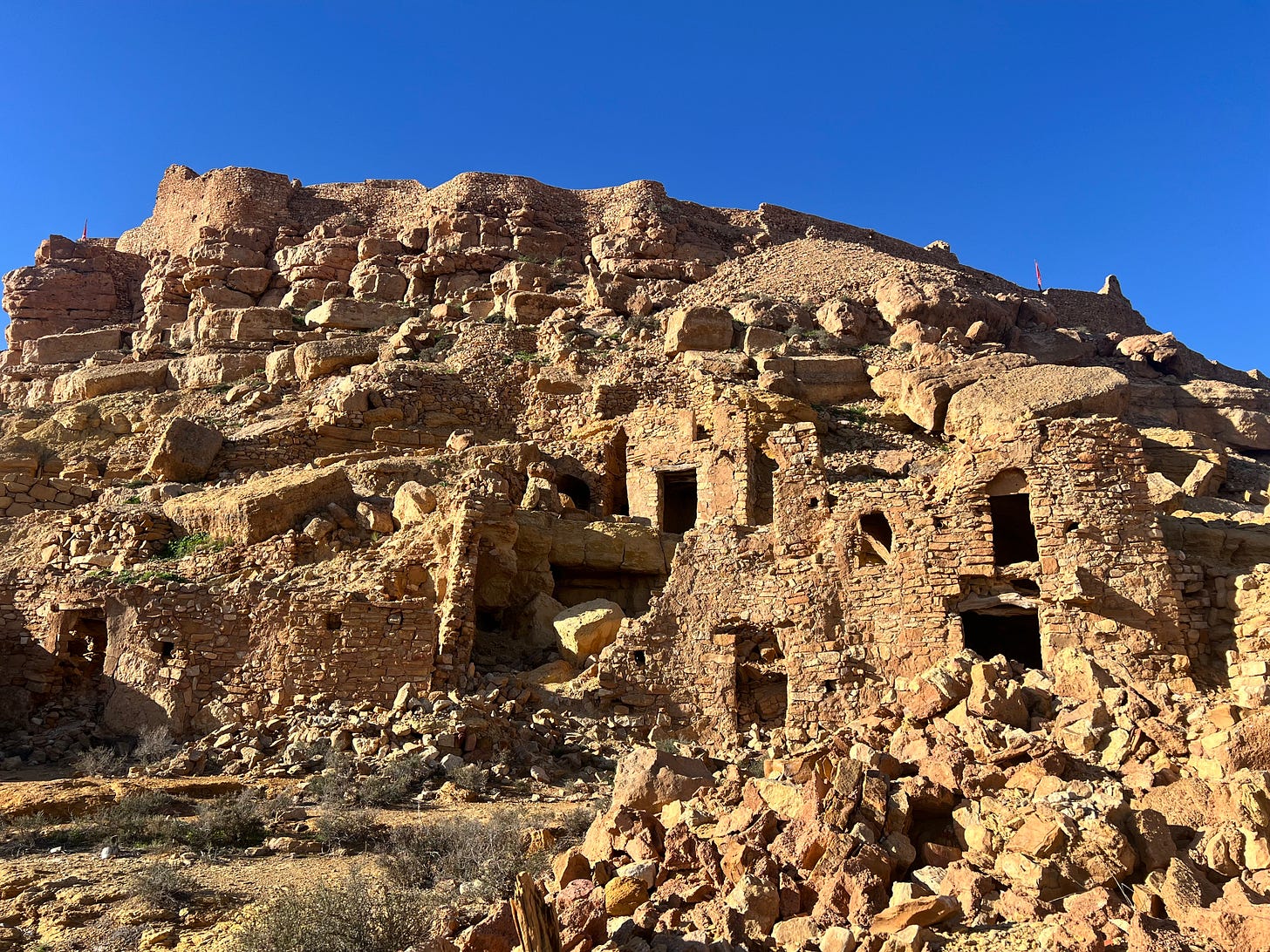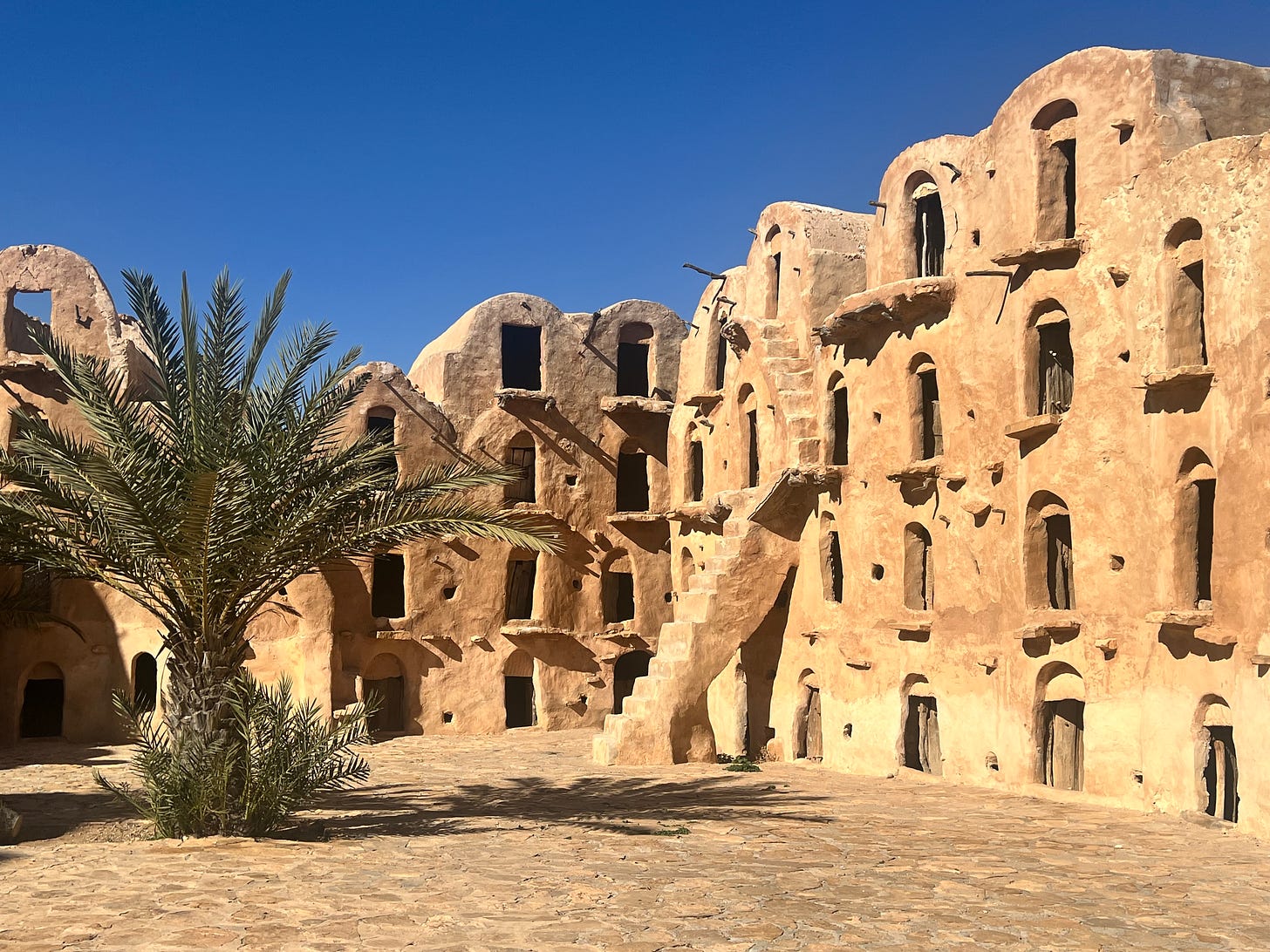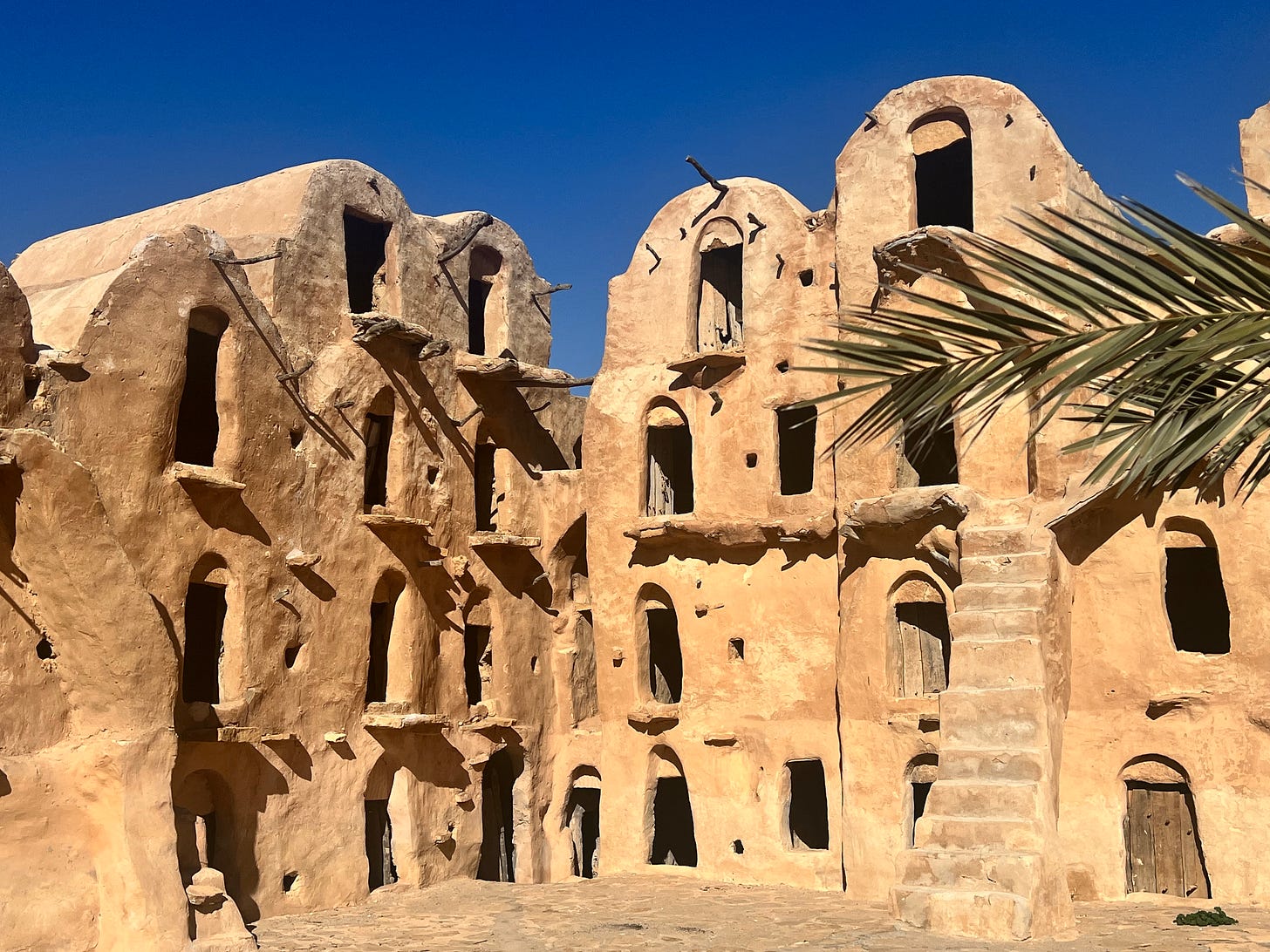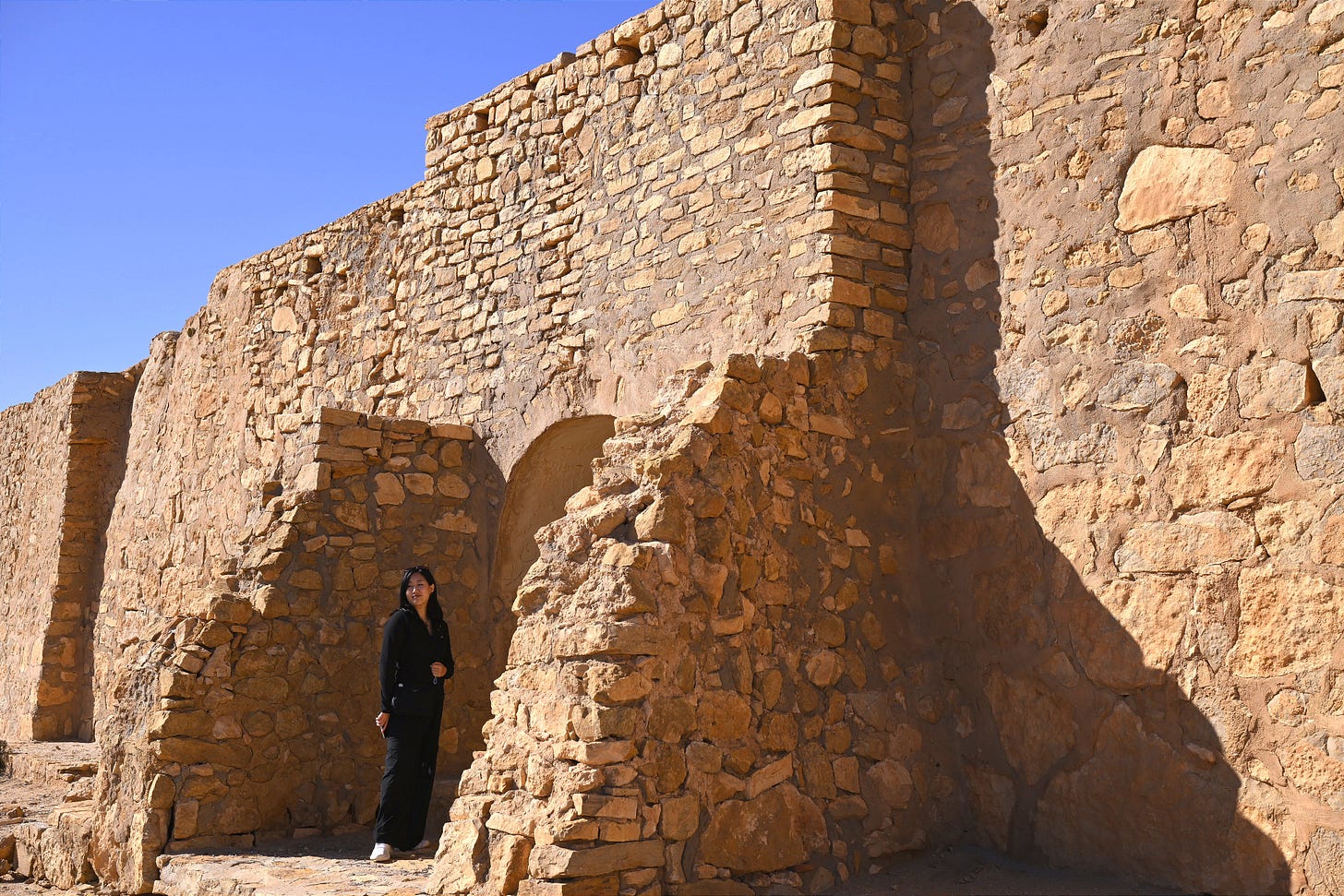From Anakin's Home to Olive-Filled Courtyards: Tataouine's Abandoned World Pt. 1
Navigating Hidden Ksour in Tunisia's Golden South
There's something about Tataouine that feels distinctly otherworldly—and not just because George Lucas borrowed its name for a fictional planet. Where Matmata's homes burrow into the earth like creatures seeking shelter from the sun, Tataouine's architecture reaches defiantly skyward, as if challenging the harsh environment rather than hiding from it. Here, the landscape itself becomes a science fiction tableau: jagged fortifications rising from golden stone against an impossibly blue sky, their silhouettes creating an alien skyline that seems both ancient and futuristic simultaneously.
Navigation in this region proves its own adventure. No helpful tourist infrastructure exists—just cryptic markers on digital maps labeled simply as "ksar" or "maisons." Each point requires interpretation and faith, with roads often dissolving into tire tracks across stony terrain. Our modest rental hatchback, designed for European city streets rather than desert expeditions, handled these challenges with mounting protest, its undercarriage scraping against rocks that appeared deliberately placed to deter casual visitors.
Debouba Beni Barka: Where Ghosts Whisper in Abandoned Halls
We started at a site marked on our map as 'Debouba Beni Barka,' though reaching it required more old-fashioned navigation skills than digital guidance. At the end of the drivable road is a pristine white mosque with its characteristic blue door, like a beacon of life to this otherwise abandoned desert mountain. We follow our instinct up a winding path. The initial troglodyte structures reveal themselves suddenly—largely collapsed and inaccessible behind fallen rocks. I found one ground-level entrance that remained passable and ventured inside. The temperature drops so dramatically that goosebumps rise despite the punishing sun outside. The darkness seems almost sentient, pressing against my skin with cool fingers of shadow, while the acoustics of still air carrying an almost physical weight amplify every breath into something more ominous. I retreat hastily, imagination conjuring spectral residents disturbed by my intrusion.
Continuing our hike up the hillside in the blazing sun without shade, we rounded a corner to discover a massive stone with vivid blue Arabic calligraphy perched at the edge of a cliff. The landscape unfurled beneath us like a topographical map come to life—an ocean of sand and stone with winding patterns etched by ancient water flows and human intervention. The biblical quality of this panorama makes our own presence feel almost sacrilegious, as if we've intruded on some primal scene from Genesis. The silence here has weight and texture, broken only by the occasional whisper of wind against stone walls that have stood sentinel through centuries of human drama. Looking across the expanse, I wondered how many Amazigh settlements remained hidden in plain sight, their earth-toned structures blending perfectly with the natural terrain unless you knew exactly where to look.
The higher we climb, the more the mountain reveals its secrets. Beyond the stone sentinel with its blue script, the path winds through a landscape where nature and human creation have begun to blur. Troglodyte structures emerge from the hillside in various states of surrender—some merely ghosts of their former selves, roof-less outlines sketched against the earth as if drawn by some celestial architect.
A wooden door stands ajar at the hill's shoulder, massive and weathered yet somehow defiant against time's persistent erosion. Cut palm trunks create an improvised pathway to this entrance, evidence that someone still tends to this place, if only to make its stories accessible to wanderers like us. We cross this threshold into what feels like a forgotten city, a honeycomb of chambers and passages carved into the hillside itself.
Walking through this abandoned settlement evokes scenes from Ben Hur's valley of lepers—particularly as my mother moves through the ruins, her face wrapped in a black scarf against the sun, an unintentional echo of Tirzah wandering among the outcasts. The resemblance is uncanny enough to create a moment of cinematic déjà vu, as if we've stepped onto a film set rather than an archaeological site.
Inside, the network of rooms tells stories of community life now silenced. Doorways lead to chambers that once served as living spaces, storage rooms, or perhaps gathering areas. The thick walls—engineering marvels of their time—still perform their climate-controlling function, creating pockets of coolness that offer blessed relief from the relentless desert sun. Small window openings, strategically placed, create ventilation patterns that speak to generations of empirical knowledge about air movement and temperature regulation.

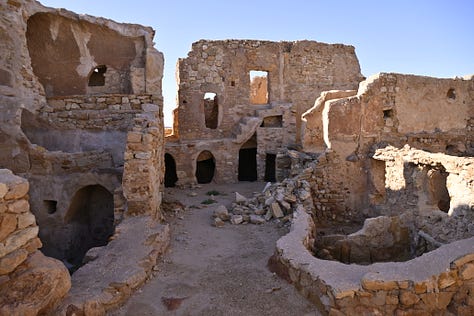
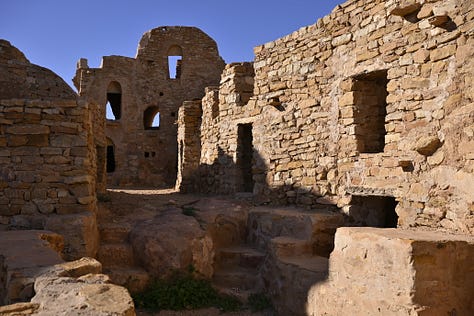
The abandonment of Debouba Beni Barka likely coincided with broader shifts in Tunisia's rural economies during the mid-20th century, when modernization and urbanization drew younger generations away from traditional agricultural practices. Without regular maintenance, these structures—built from sun-dried brick and stone—gradually succumb to erosion, each passing year erasing another fragment of cultural heritage.
Our descent brings us face-to-face with four newborn puppies, their playful energy providing stark contrast to the somber ruins. One particularly brave explorer makes a determined chase after us, ascending my leg and clinging to my chest with surprising strength. His warm weight against my heart feels like a living reminder of resilience in this seemingly forsaken place. I reluctantly take him off my arms to reunite with his mother who must be nearby preparing to feed these hungry adventurers. With a final glance at the pup running back to his siblings, the journey continued.
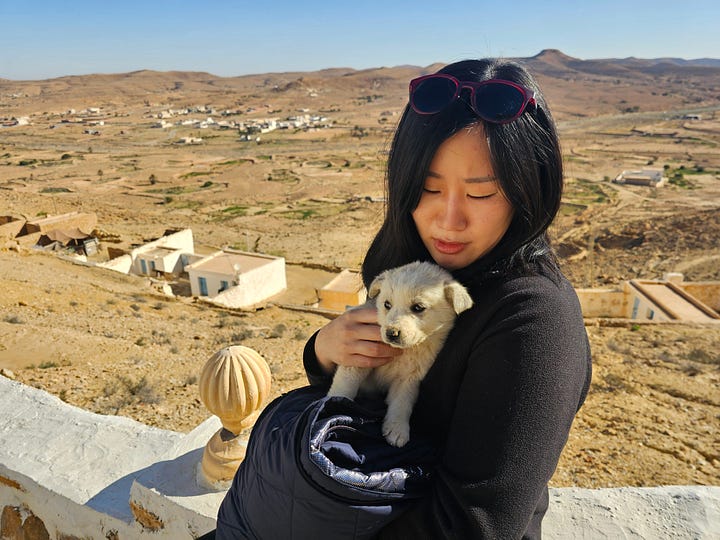

Ksar Ouled Soltane: The Vertical Village that Inspired a Galaxy
The contrast between Ksar Ouled Soltane's global fame and its local obscurity creates cognitive dissonance. This spectacular multi-story granary—where scenes of young Anakin Skywalker's home were filmed for "Star Wars: The Phantom Menace"—sits tucked away in a sleepy village whose residents seem utterly indifferent to their architectural treasure. A few modest signs point toward the entrance, but nothing prepares you for what lies beyond the humble wooden door.
The courtyard reveals itself with theatrical grandeur—a central plaza surrounded by four stories of ghorfas (storage chambers) arranged in a mesmerizing honeycomb pattern. Each cell features a distinctive arched doorway, originally designed to store grain, oil, and other valuables above ground level. Wooden beams protrude at regular intervals—not decorative elements but functional supports used during construction and for climbing when stairs weren't an option. The entire structure rises from locally-quarried stone that captures light like a living substance, transforming from pale sand to burnished gold as the sun traverses the sky. The overall scene suggests an apartment complex, each family maintaining private storage units within a communal defensive structure.
The engineering principles embedded in this architecture reveal sophisticated understanding of environmental management. Thick walls provide thermal mass, absorbing heat during day and releasing it slowly at night. Small windows and strategic orientation minimize direct sunlight while maximizing ventilation. The central courtyard creates a microclimate that can differ by 15 degrees Celsius from the surrounding desert. What might appear primitive at first glance represents generations of empirical knowledge about sustainable desert living.
These structures represent a particular architectural tradition known as 'ksour' (plural of ksar), developed by the indigenous Amazigh people. Ksar Ouled Soltane dates to the 15th century, though similar structures in the region have been documented from as early as the 12th century. Its dual purpose as both storage facility and defensive fortification speaks to the historical instability of this border region, where the Amazigh communities navigated complex relationships with Arab rulers, Ottoman officials, and eventually French colonizers. The ksar's impressive state of preservation stems partly from continuous use until relatively recently—many families only abandoned traditional granary storage in the 1970s as mechanical agriculture and modern transportation made centralized facilities more practical.
In the courtyard, two young artists had set up modest displays, competing for the attention of visitors who might never arrive. One clearly possessed more technical skill, the other seemed to be learning by imitation—watching and replicating his neighbor's technique. I tried to focus on the architecture, but found my gaze repeatedly drawn to their watercolors: vivid renderings of Tunisian doors and the very courtyard where we stood. Despite my initial resistance, the paintings kept pulling me back—their captured essence of this ancient place proving irresistible. After the obligatory negotiation dance (performed with the expected theatrical sighs and reluctant concessions from both sides), I surrendered to temptation and acquired two pieces to carry home—tangible memories that would outlast any photographs.
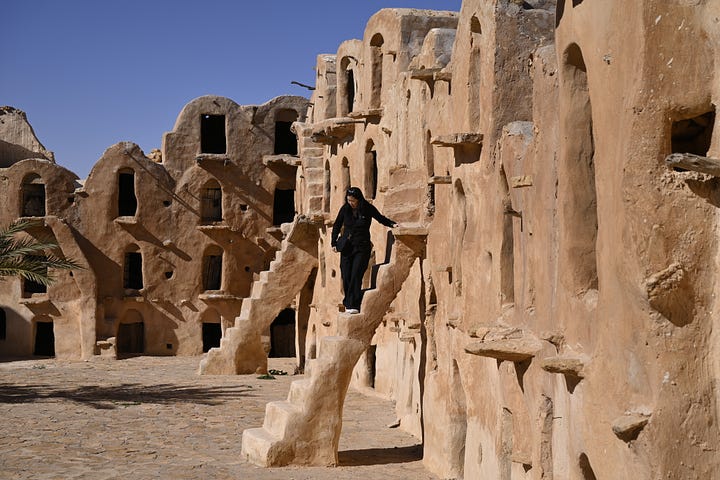
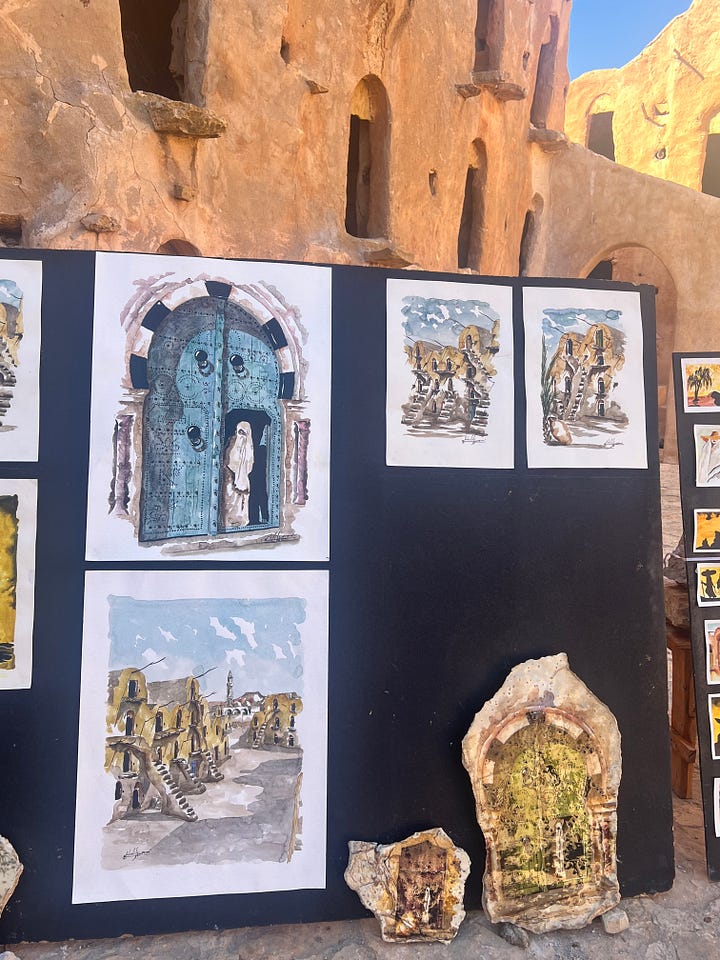
While Matmata's Hotel Sidi Driss embraces its Star Wars connection with costume displays and endless soundtrack loops, Ksar Ouled Soltane maintains dignified distance from its pop culture fame. Nearby, local men play cards with intense concentration, completely uninterested in the visitors photographing what is, to them, simply part of the landscape.
Ksar Aouadid: The Fortress of Living Olives
By mid-afternoon, family dynamics intensify into a minor diplomatic crisis. My aunt—the organizational backbone of our expedition—references our distant Hammamet hotel reservation with increasingly pointed remarks about timing and half-board meals that won't wait. Meanwhile, my uncle and I, intoxicated by archaeological discovery, advocate for "just one more ksar" with the reckless enthusiasm of treasure hunters who've glimpsed gold.
Using questionable map-reading skills honed through years of girl scouts training, I direct our increasingly resistant driver up what can only charitably be called a road. The rental car, more reluctant than the driver, voices mechanical complaints with each rocky incline. What appears on Google Maps as a simple route reveals itself as a mountain goat path that our city-bred vehicle navigates with visible toil.
After what feels like a geological age of off-roading (but was likely just two miles), we arrive at massive iron gates set into imposing stone walls. This entrance appears truly abandoned—its ancient hinges rusted into position. It takes surprising force to create an opening barely wide enough to slip through, suggesting we might be the first visitors in months or even years.
The tableau within stops conversation mid-sentence. Four intertwined olive trees dominate the central courtyard, their gnarled trunks testimony to centuries of tenacious survival. While the surrounding architecture slowly surrenders to entropy, these venerable trees continue their biological imperative—heavy with fruit, their silvery leaves creating a hypnotic dance of light and shadow across the courtyard's stone floor.
Surrounding this living heart stands another multi-level structure similar to Ouled Soltane but with subtle architectural differences. The staircases here feature more pronounced angles, the support beams extend further from walls, and the ghorfas slightly larger. These variations suggest regional building traditions even within Tataouine's relatively small geographical area—each community developing slight modifications to address specific local conditions.
Ksar Aouadid likely served similar functions to other granaries in the region, though its more remote location suggests it may have been built by a single extended family rather than serving an entire village. The impressive olive trees at its center indicate continuous cultivation for several centuries—research suggests some North African olive trees can live up to 2,000 years, making them living links to Roman and Carthaginian times. The careful integration of these trees into the architectural design demonstrates the holistic approach Amazigh builders took toward their environment—working with natural features rather than imposing entirely human designs.
The abandonment patterns here mirror the broader story of rural Tunisia's modern transformation. Without regular maintenance, these structures—built for constant human attention—began their slow return to the earth from which they rose. The olive trees, requiring less intensive care, outlasted their human caretakers. The juxtaposition creates a living metaphor: nature's persistence alongside human transience.
Our day in Tataouine represents only half of our desert adventure. The mountain settlement of Chenini awaits with its own remarkable architecture and deeper insights into Tunisia's Amazigh communities. That journey, with its clifftop mosques and vertical dwellings carved directly into mountainsides, demands its own telling.
As we step back out through the metal gates of Ksar Aouadid, I take one last photograph of the olive trees against the golden walls, trying to capture something that seems fundamentally uncapturable: the poignant beauty of human creation returning to nature, and the silent wisdom of a sustainable way of life we've nearly forgotten.
Finding home between weathered stones and timeless olives,
Susie
Coming next:
The mountain citadels of Chenini—where Amazigh heritage clings to vertical cliffs




